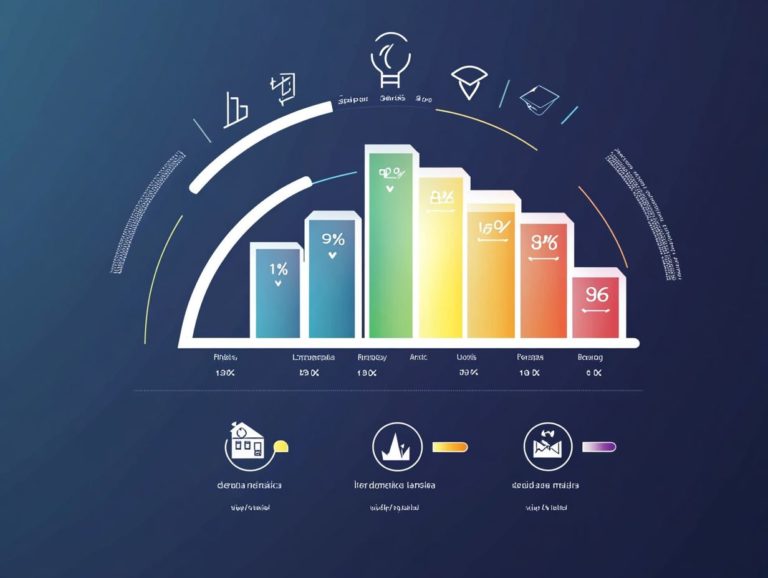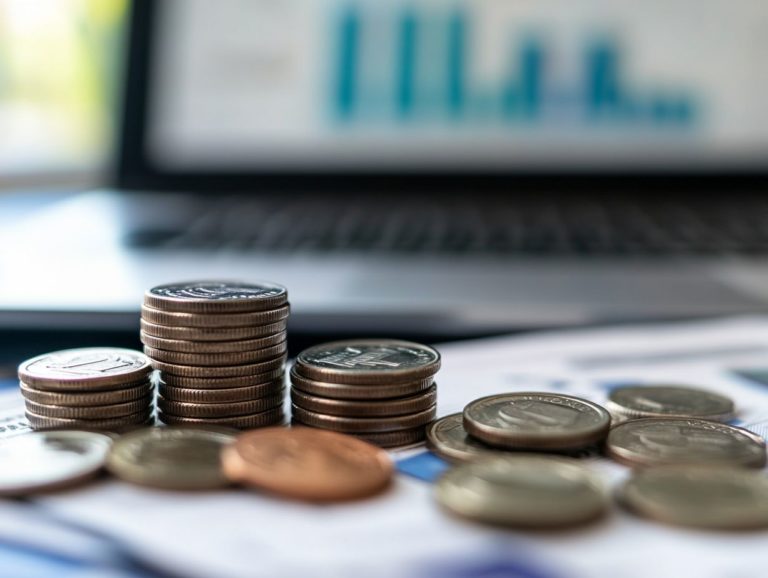What to Expect from Peer-to-Peer Lending Returns
Peer-to-peer lending is transforming how individuals approach borrowing and investing. This innovative financial model connects borrowers directly with lenders, crafting a distinct marketplace for personal and business loans.
You ll discover the fundamentals of peer-to-peer lending, how it operates, and the key factors that influence your returns. By gaining insight into interest rates, loan terms, and diversification strategies, you’re positioning yourself to maximize potential returns while skillfully navigating the inherent risks.
Dive into this exciting journey and explore the changing world of finance!
Contents
- Key Takeaways:
- Understanding Peer-to-Peer Lending
- How Peer-to-Peer Lending Works
- Factors Affecting Peer-to-Peer Lending Returns
- Expected Returns from Peer-to-Peer Lending
- Maximizing Returns through Diversification
- Frequently Asked Questions
- What factors affect the returns of peer-to-peer lending?
- How are the returns calculated in peer-to-peer lending?
- What is the average return rate for peer-to-peer lending?
- Are the returns in peer-to-peer lending guaranteed?
- How long does it take to see returns from peer-to-peer lending?
- Are there any taxes on peer-to-peer lending returns?
Key Takeaways:

Peer-to-peer lending connects individuals directly for loans. This cuts out traditional banks and offers better returns.
The process involves borrowers requesting loans and investors funding those loans, with the platform facilitating the transactions.
Interest rates and loan terms, as well as risk and default rates, are key factors that can affect the returns of peer-to-peer lending investments.
Expected returns from peer-to-peer lending can vary, but on average, investors can expect to earn higher returns compared to traditional savings accounts or bonds.
Diversifying investments and using strategies to reduce risk can help investors maximize their returns in peer-to-peer lending.
Understanding Peer-to-Peer Lending
Understanding Peer-to-Peer (P2P) lending is crucial for you, whether you’re a borrower or an investor seeking alternative financing options beyond traditional lenders.
P2P lending platforms like LendingClub, Prosper, and Upstart serve as a bridge. They connect individuals in need of personal loans with investors eager for attractive returns on their investment capital.
This innovative financial model caters to borrowers who might face challenges accessing credit due to poor credit history or an absence of established credit scores, enabling them to secure the funding necessary for a range of personal and business endeavors.
What is Peer-to-Peer Lending?
Peer-to-Peer lending, or P2P lending, is a financial innovation that connects you directly with individual investors through online platforms. It allows you to bypass traditional lenders like banks and credit unions.
This new method enables you and businesses alike to access funds more efficiently, often resulting in competitive interest rates and favorable terms.
As you navigate this diverse landscape, you’ll encounter borrowers seeking personal loans for life events think weddings or vacations alongside small business owners in need of quick capital to drive their operations forward.
P2P platforms typically present a variety of loan options, including secured loans, which require collateral, and unsecured loans, which do not. They also offer specialized choices like student loans or debt consolidation.
These lending avenues not only make funding more accessible for a broader spectrum of borrowers but also offer attractive opportunities for investors looking for better returns than what traditional savings accounts or bonds can provide.
How Peer-to-Peer Lending Works
In the realm of Peer-to-Peer (P2P) lending, you ll find an elegantly streamlined process at play.
When you submit your online application to a lending platform, it meticulously evaluates your profile, loan request, and credit history. This careful assessment leads to personalized loan offers crafted specifically for you by potential investors.
The Process of Borrowing and Lending

In the P2P lending process, you start by filling out an online application on lending platforms. These platforms will review your financial profile to determine the most suitable loan terms, including interest rates and repayment conditions.
After submitting your application, the platforms assess your ability to pay back, often relying on metrics such as your credit score, income, and existing debt. This analysis is key in establishing competitive interest rates that accurately reflect the risk associated with your loan.
Once approved, you will receive detailed information about repayment schedules and any applicable fees, such as origination fees or late payment charges. Knowing these details helps you plan your finances better.
Understand that missed payments can lead to penalties, which can adversely affect your credit rating. By managing your loan repayment properly, you can ensure a smooth process for everyone involved.
Factors Affecting Peer-to-Peer Lending Returns
- Interest rates
- Loan terms
- Risk assessments of borrower profiles
- Current default rates on loans facilitated through different lending platforms
Each of these elements plays a critical role in determining the potential profitability of your investment strategy.
Interest Rates and Loan Terms
Interest rates and loan terms in P2P lending are pivotal in shaping both your eligibility as a borrower and the returns you can expect as an investor. These factors directly influence the feasibility of funding loans and the associated risks of borrower defaults.
You ll encounter various interest rate models, such as risk-based pricing and dynamic rates. Each presents unique scenarios for borrowers. Your profile encompassing credit scores, income levels, and debt-to-income ratios can lead to significant variations in the terms offered.
For example, a higher credit score can unlock lower rates, offering you incentives for timely repayments and reducing the risk of default.
As an investor, you need to carefully scrutinize these profiles, as they significantly affect your potential returns. Building a diverse portfolio can be an effective strategy for mitigating risks when lending to higher-risk borrowers.
Thus, understanding the intricate relationship between borrower characteristics and loan structures is essential for anyone navigating this rapidly evolving financial landscape.
Risk and Default Rates
Understanding the risks associated with P2P lending is essential, especially regarding default rates. These rates can vary significantly based on the risk assessment of borrower profiles and the broader lending environment shaped by financial institutions.
Default rates can considerably impact your investment returns, leading to potential losses if you don’t take the necessary precautions. Rely on platforms that conduct thorough risk assessments to gauge the creditworthiness of borrowers, utilizing data analytics and a variety of financial metrics.
Such platforms can help reduce your risk exposure through smart diversification strategies. By spreading your capital across multiple loans, you can mitigate the chances of defaults. Employing stringent credit criteria and maintaining ongoing monitoring of borrower performance can boost your confidence as an investor and contribute to a more reliable lending marketplace.
Expected Returns from Peer-to-Peer Lending

Expected returns from Peer-to-Peer (P2P) lending can fluctuate considerably. They are influenced by various factors such as the risk profile of borrowers, current interest rates, and the broader economic landscape.
This ever-changing landscape opens up exciting investment opportunities for you as an investor seeking interest income.
Average Returns and Potential Variations
The average returns from P2P lending typically fall between 5% and 10%. However, you might encounter variations based on your chosen investment strategies, borrower risk assessments, and prevailing market conditions that impact alternative investments.
It’s essential to recognize that returns can fluctuate due to individual borrower profiles and the specific platforms you select for lending. Factors such as loan duration, platform fees, and broader economic trends can greatly affect your net gains.
For example, using a diversified investment approach allocating your funds across various risk categories can enhance your overall performance. Understanding default rates and the importance of careful credit assessments is vital for maximizing your P2P investment outcomes.
Maximizing Returns through Diversification
Maximizing your returns in Peer-to-Peer (P2P) lending demands a meticulously crafted investment strategy. Embracing diversification, which means spreading your investments across different loans to reduce risk, is key as it mitigates the inherent risks of P2P lending and effectively reduces the impact of borrower defaults on your portfolio.
By thoughtfully distributing your investments, you can safeguard your assets while enhancing your potential for returns.
Strategies for Reducing Risk and Increasing Returns
To effectively navigate the P2P lending landscape, you can adopt various strategies designed to reduce risk while simultaneously boosting the returns in your investment portfolio, all while focusing on selecting optimal loan offers.
By conducting thorough research on individual loan offers, you can uncover key risk factors associated with each borrower, such as credit scores, income verification, and repayment history.
It’s also crucial for you to diversify your investments across a variety of loans; this approach helps mitigate the impact of any single loan defaulting. Consider spreading your funds across multiple loans instead of concentrating them in just one.
Engaging with reputable P2P platforms that provide detailed analytics will enhance your decision-making process, ultimately leading to more informed investment choices.
Frequently Asked Questions

What factors affect the returns of peer-to-peer lending?
Several factors play a role in your returns. The borrower’s creditworthiness, the platform’s loan selection process, and the current economic conditions can all influence your earnings.
How are the returns calculated in peer-to-peer lending?
The returns in peer-to-peer lending are calculated based on the interest rate set by the lender and the repayment schedule of the borrower. The platform may also deduct a fee for facilitating the loan.
What is the average return rate for peer-to-peer lending?
The average return rate for peer-to-peer lending varies depending on the platform and the type of loans offered. On average, investors can expect returns ranging from 5% to 9% annually.
Are the returns in peer-to-peer lending guaranteed?
No, the returns in peer-to-peer lending are not guaranteed. As with any investment, there is a risk of default by the borrower, which can result in a loss of returns. It is important to carefully review the borrower’s creditworthiness before investing.
How long does it take to see returns from peer-to-peer lending?
The time it takes to see returns from peer-to-peer lending can vary depending on the loan term and repayment schedule. Some loans may have shorter terms, while others may have longer terms with monthly or quarterly repayments.
Are there any taxes on peer-to-peer lending returns?
Yes, peer-to-peer lending returns are subject to taxes, similar to any other investment income. It is important to consult with a tax advisor for specific information on how these returns may be taxed in your country or state.
Ready to start investing? Explore your options now!






